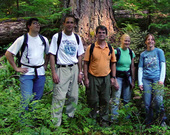Highlight
Students Team up to Uncover Mysteries of the Earth's Subsurface Biosphere
Achievement/Results
Each year graduate students who are part of an NSF-supported Integrative Graduate Education and Research Traineeship (IGERT) program on the Earth’s Subsurface Biosphere (ESB) at Oregon State University (OSU) and Portland State University (PSU) team up to examine an issue related to life beneath the Earth’s surface. This hands-on experience introduces students to the dynamics of working as a team on an interdisciplinary project and provides them with the skills to work effectively on collaborative efforts. The students’ projects also result in tangible products, such as research reports, grant proposals, and scientific articles.
As part of the ESB curriculum, a cohort of second-year students, which represent a wide range of scientific disciplines, comes together to work an interdisciplinary project under the guidance of one or more faculty members. By design, all decisions, including the selection of faculty advisors and the research topic and product, are left up to the students. The exercise is called Group Process Training (GPT).
To date, five student cohorts have participated in GPT. The topics and products of their efforts have been wide-ranging, but each student has learned to understand and work with those of different backgrounds, interests, and disciplinary expertise. Students have learned how to communicate ideas across scientific disciplines, reach mutually agreeable compromises, lead productive meetings, identify priorities, set goals, and produce written products that can stand the scrutiny of peer review. Because GPT students are at two different campuses, they have also mastered the ability to work effectively at a distance using modern technology.
One GPT group chose to draft a research proposal. They proposed to study the functioning of microbial mats that grow on the bottom of Crater Lake in Oregon. Crater Lake is the deepest lake in the United States and is known for its clear water, which reflect its low nutrient status and poses the question of how these mats gain their energy. The proposal hypothesized that the mats are formed by iron-oxidizing bacteria that grow on reduced forms of iron present on the lake bottom. Such phenomena are known to occur in other environments, such as hot springs, ocean vents, acid mine drainages, etc., but are poorly described in lacustrine ecosystems.
A second GPT group chose to do a research project to obtain preliminary evidence for anaerobic biodegradation of polycyclic aromatic hydrocarbons (PAHs) at the McCormick and Baxter Superfund Site located in Portland Harbor on the Willamette River. They sampled pore water and sediment at three locations at the site and performed a comprehensive chemical characterization. Two locations showed no evidence of PAH contamination, but the third location had high PAH concentrations and displayed evidence that it was undergoing biodegradation. The results of their study were presented in a report to the Oregon Department of Environmental Quality (DEQ). One student subsequently received a research grant from the Oregon DEQ to support further research at the site as part of her graduate program.
Several GPT groups have selected to write a review article on a topic of current scientific interest in the subsurface biosphere. One group reviewed the production, transport, and fate of hydrogen gas in deep subsurface environments. A second group (see photo) reviewed anaerobic oxidation of methane (http://sbi.oregonstate.edu/news/200710.htm). Thereviewer review was recently published in Environmental Science and Technology (Caldwell et al., 2008). The current GTP students are preparing a forum article for submission to the American Geophysical Union’s news journal, EOS. They are evaluating the importance of subsurface biosphere research in the context of the scientific community and the role that interdisciplinary training and research plays in this field. The article is intended to be an analysis of the progression of subsurface biosphere research and the driving forces and components that make this research successful and significant.
Solutions to today’s global challenges typically require input from multiple disciplines, and more importantly individuals with the ability to bridge disciplines and find unique solutions. The training provided by the GPT course that is part of the NSF-sponsored ESB-IGERT program is an effective way for providing these skills to the next generation of scientists who will tackle these complex problems.
Address Goals
This activity directly trains students and provides them with the practical skills to work as part of an interdisciplinary team. Although a guided exercise, the students are responsible for creating their project, which involves identifying a topic of scientific importance.






